Bus
You can go virtually anywhere in Indonesia with a bus (provided that there is not significant sea crossing on the way). Some companies operate bus between Banda Aceh and Jakarta or from Jakarta to Bima (Sumbawa) !
The thing you need to know is from which terminal the bus leaves (often they are more than 1 in each town) and the schedule. There is no way to tell in general, ask the locals. I also try to indicate them for every destination I cover.
You could also do like the locals and wait by the side of the road for the bus to pass.
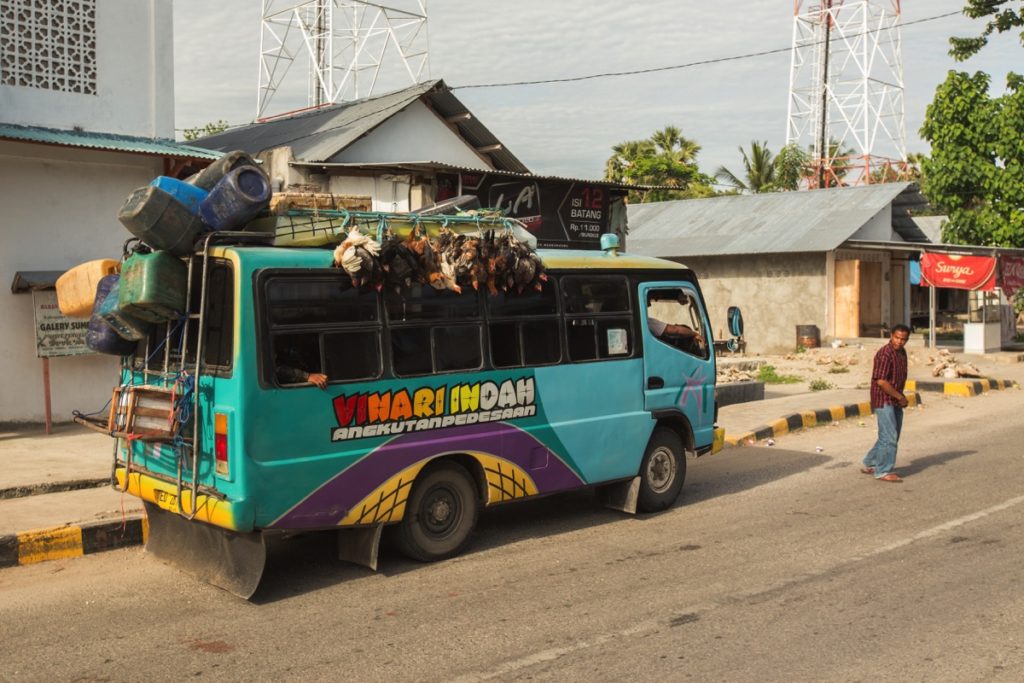
Bus classes
Buses come in different level of comfort. Unfortunately sleeper bus are not common in Indonesia.
On popular routes, you have usually the choice between economy bus (no AC and people often smoke inside it) and AC bus, often called VIP / bisnis / patas …
It is now possible to buy to bus ticket online through 3rd party reseller (like Traveloka) but most of the time only the most expensive bus are available.
Shared taxi
Any destination served by a bus is usually also served by a shared taxi. They are simply private cars operated sometimes by independent drivers but most of the time by travel agencies. The term travel to refer to shared taxi is widespread throughout Indonesia. In some areas they are refered to as taksi which can be a bit confusing at first, but it is usually an area where you have no chance to get a regular taxi.
Travel usually offers door-to-door pickup but they also often start from a designated point in town. They are slightly more expensive than bus and supposed to be a bit faster.
Given a travel requires much less investment than a bus, many places outside the overpopulated provinces are only served by travel.
Car plates in Indonesia
If the travel is registered, then the car plate is supposed to be yellow. So if you are waiting for a travel from the side of the road, you know which car to flag down.
Yet many travel are not fully compliant with the regulation and use a regular private car plate. Passengers bus are also supposed to have a yellow plate.
Otherwise green plates are for the military and red ones for the government cars.
The last two figures on the car plate tell you the place of registration of the vehicle : B for Jakarta, D for Bandung, L for Surabaya …
For the full list, have a look here.
City transport
Cities in Indonesia are usually not the most enjoyable places because of dire traffic conditions. Jakarta is definetly the most congested cities of all South-East Asia (way worst than Bangkok or Manilla). As of 2018, the first MRT of the country is still being built in Jakarta.
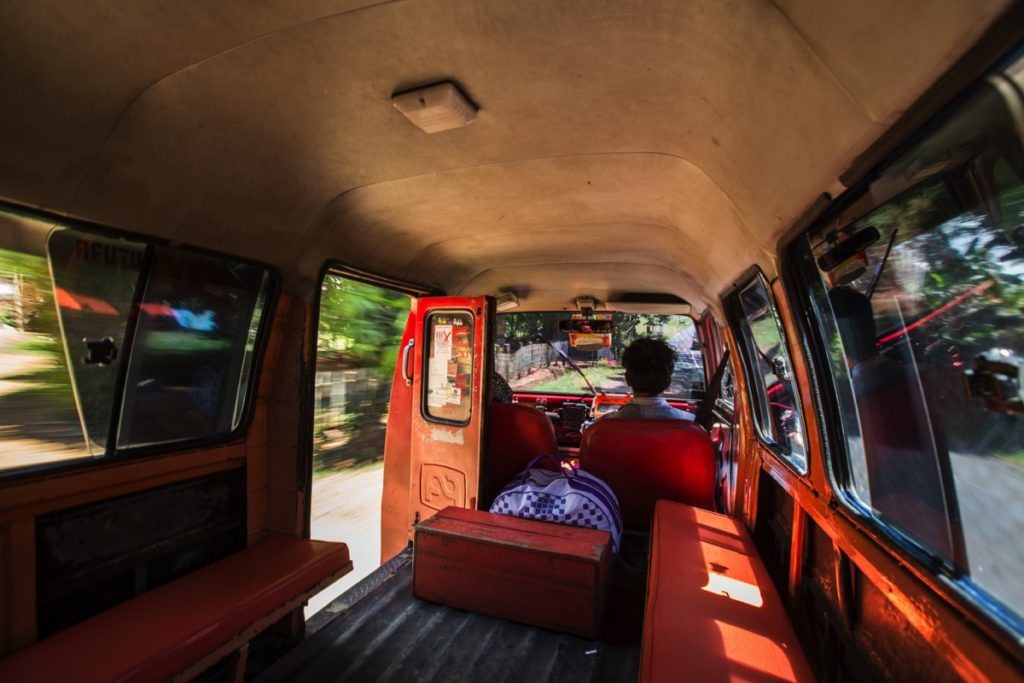
City minibus (angkot)
Virtually any town in Indonesia have a terminal serving as a base for public minibus (most of the time not the same as the bus terminal). They are often refered to as bemo in guides but the term is not generic.
Originally bemo stands for becak motor, but in some regions, the word became a generic term for public minibus.
- In Jakarta, the old terms oplet (refering to modified Mirror Minor 1000 Traveler used since the 50s) or mikrolet (rolled out from the 80s and usually based on Toyota Kijang) are still widely used
- In south Sulawesi, they prefer the term pete-pete
- In north Sulawesi they are called mikro
- In East Kalimantan, they prefer the term taksi
- In north Sumatra, modified pick-up for passenger-transportation are called labi-labi …
- Bemo is widely used in East Java
It is more convenient to use the Indonesian word angkot (for ankutan kota) which is the actual generic term. Anyway, no matter the term used, you’re are referring to a kind of minibus able to pick-up about 10-15 passengers.
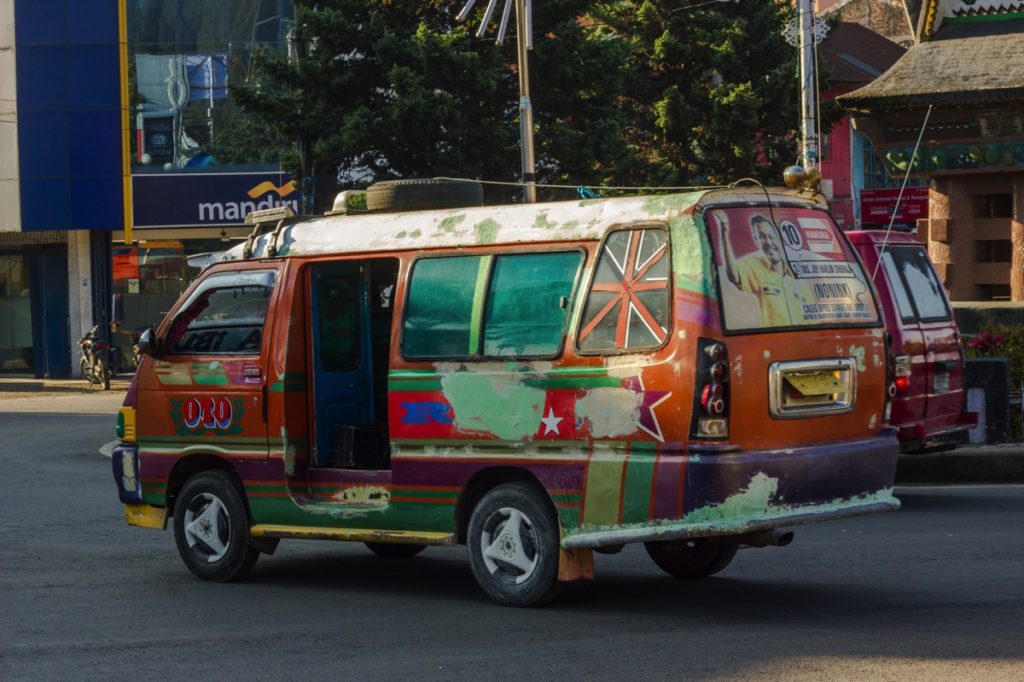
Angkot follows a defined route in town. From small towns, specific angkot usually visit the nearby villages. In that case, the itinerary is likely to be modified depending on the request of passengers.
To take an angkot, simply flag it down from the side of the road using your hand. Prices are cheap (almost never more than 5’000Rp, usually 2’000Rp), in many town, price is even fixed. If you Indonesian is hesitant, drivers may be inclined to inflate their price for you. Otherwise if you don’t ask for something unreasonable (like giving a destination that is absolutely not on the classic itinerary), drivers usually do their best to help you out.
To stop the angkot as a passenger, the custom varies from one town to another, the safest solution is to yell kiri (left) to the driver. You can call any driver om (uncle), unless he is a woman of course but this is a rare sight, so usually you’ll hear people saying kiri om !
Regional custom may be different. In Ambon for instance, people often ring the handler with their key or another metalic object to ask the driver to stop.
Motorbike taxi (ojek)
Universally known as ojek, they are convenient to navigate congested cities or to cover short distance for a single passenger.
In town, the old-style ojek have been totally disrupted by the two online-ojek platforms Go-jek (from Indonesia) and Grab (from Malaysia). Uber was also operating online ojek for some time but their operations have been sold to Grab. Online ojek is often shorten up to ojol.
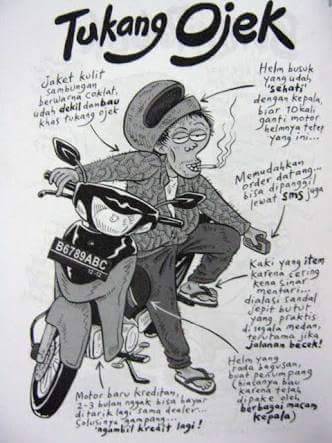
Grab or Go-jek are invariably the most convenient individual transport solution in an Indonesian city, and often the cheapest.
City bus
Some large Javanese towns (like Jakarta, Surabaya or Yogyakarta) also operate a fleet of large passenger buses in addition to the private fleet of minibuses.
The problem in Jakarta is that the Transjakarta gets stuck in the traffic with the other vehicle. They also share the road with older Kopaja and Metromini.
Other city transportation falling into disregard
Becak are old-fashioned peddycab built on a bike or a motorbike. You can still see them from times to times in middle-size town.
Bajaj were very common in Jakarta until their recent ban.
Horse cart called oplong still exists in rural area.
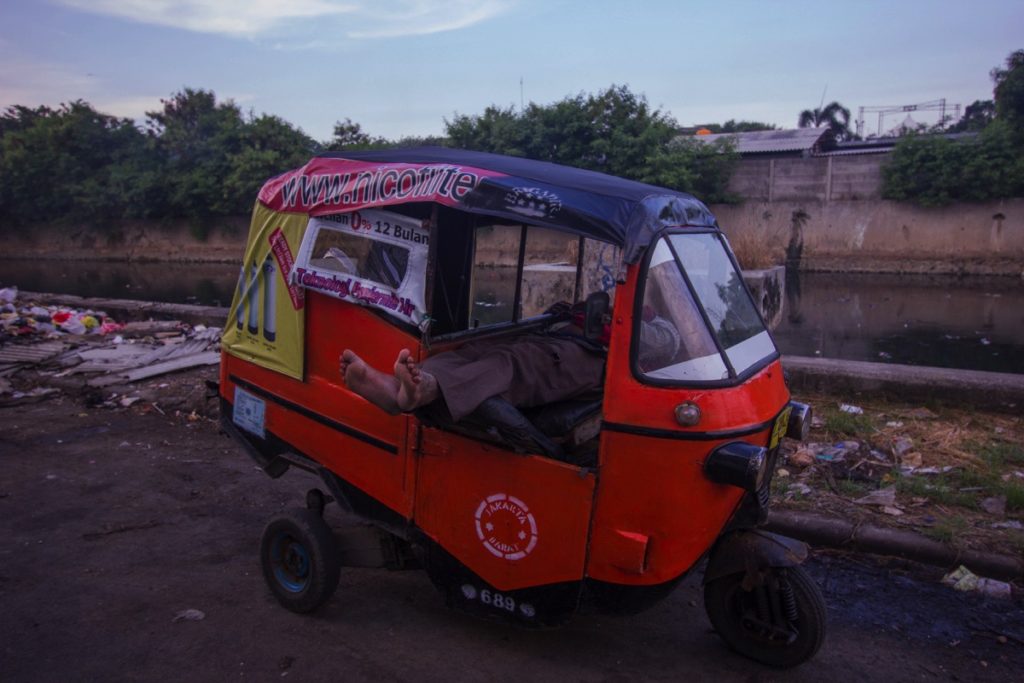
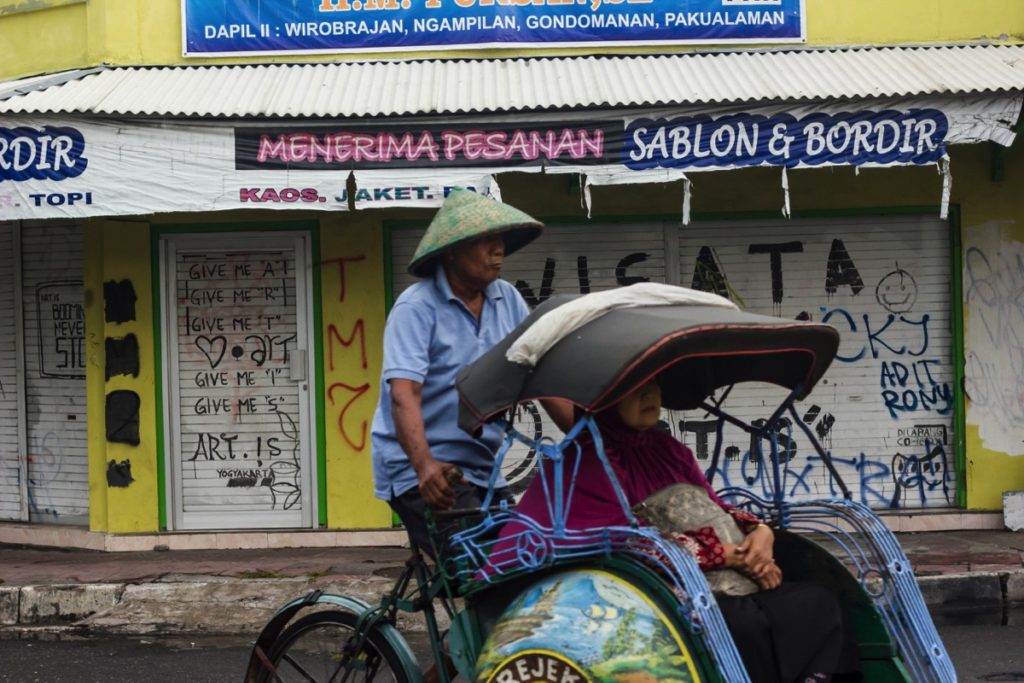
Renting a motorbike
Motorbikes are a great way to explore the country on your own. They can be rented rather easily in most parts of the country for a daily price between 40’000 and 150’000Rp depending on the competition among rental business in the area.
Besides sport motorbikes, virtually all bikes available in Indonesia have automatic or semi-automatic gears
The vehicle registration card is called Surat Tanda Nomor Kendaraan (STNK) and shall be shown to police officer in case of a control.
Motorbike licence (Surat Izin Mengemudi > SIM) is mandatory for all drivers. The motorbike licence is called SIM-C. Besides South Bali, policemen are usually very tolerant with international driving licences.
Don’t believe idiots telling you to not stop at police control, and that’s what every local do. This is pure bullshit, yes many Indonesian drive near their house or their village without licence, plate or helmet but they know everyone in the area and you can be sure that someone will text them the position of the policemen maximum 5 minutes upon their arrival.
What kind of gas to buy ?
Stopping at the gas pump can be a bit confusing the first time, here are the differences :
- Premium (RON 88, yellow one) : the most common subsidized gas sold around 7’000Rp/liter [Update 2022 : premium doesn’t exist anymore]
- Pertalite (RON 90, green one) new formule rolled out in 2015 sold around 8’000Rp/liter
- Pertamax (RON 92, blue one) sold around 10’000Rp/liter
- There a couple of more expensive Pertamax brand like Pertamax Plus, Pertamax Turbo, Pertamax Dex …
Premium is subsidized gasoline, so it’s cheaper but not always available. Often, you have a long queue to get some Premium and none to get Permatax, so some people buy Pertamax to save some time. From a mechanical point of view, the gas you should use depends on the engine of your vehicle. For most of Indonesian, price is the most important factor anyway.
Solar/Biosolar are diesel, use them only if you have the right engine.
The color of the gas help you to know what you are buying from resellers by the side of the road. You usually pay a premium of 2’000-3’000 Rp/liter.
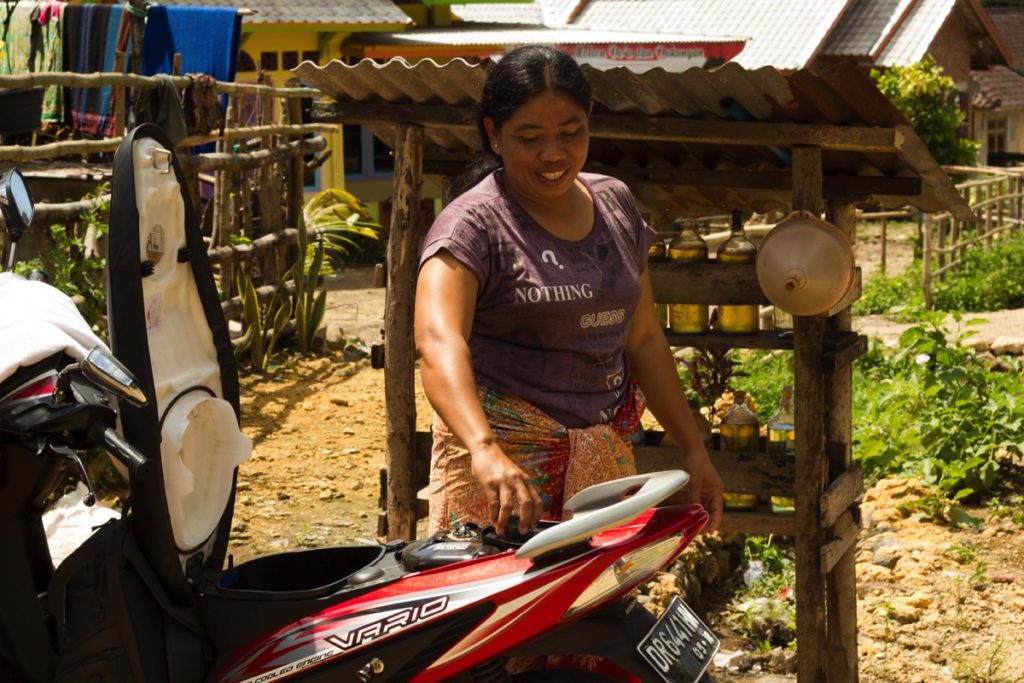
Buying a motorbike
The Indonesian adminstration does not make it easy for traveler to buy a motorbike in Indonesia.
First of all : to buy a new motorbike, the dealer will need a KTP (Indonesian ID) to produce the registration card (STNK). More exactly he needs a NIK (Nomor Induk Kependudukan, civil registration number), that you could have issued even as a foreigner by registering with a permanent or temporary residency permit (KITAP/KITAP) at the catatan cipil.
As a traveler, you won’t have any of these so buying new is not an option.
You could also buy second-hand and never register yourself as the new owner of the bike. Many Indonesian do that in order to avoid paying mutation taxes. They just keep the blue book as a proof of ownership (Buku Pemilik Kendaraan Bermotor > BPKP)
Nevertheless in the future you will probably encounter 2 issues :
- You need to pay a yearly vehicle tax in order for the vehicle to be compliant with the law. This vehicle tax can be paid only at the Samsat (to keep it simple, the adminstrative office dealing with vehicle matters) which has registered the vehicle and by the official owner of the vehicle (with ID proof). So if your motorbike is registered in Medan, you need to pay your tax in Medan, which might be difficult if you are in Lembata.
- The STNK has a validity of 5 years and can also be renewed only at the Samsat at which the vehicle has been registered, with original proof of ID.
- You may not care much about that if the tax have been paid 2 month ago and the STNK is still valid for a year, giving you 10 month of tranquility ahead.
- If you plan to sell the vehicle then the new owner will probably ask for the proper document to register himself as the new owner of the bike. And this can be done only by the official owner of the bike, with proof of ID, at the bike’s local Samsat. Then the new owner will engage in a time-consuming procedure to change the place of registration of the bike.
- Many people prefer selling their vehicle in their region before moving to another one to avoid all this administrative pain.
- Basically, selling back your second-hand bike to someone different that the person you bought it from and even more in another province will definetly be very difficult.
Train
Train is a very convenient way to travel, especially on Java island where the rail network is the most developped.
To book train tiket, the most convenient solution is to use online resellers like Tiket.com or Traveloka. Not every tickets can be bought though, for instance the 8’000Rp train between Yogyakarta and Solo.
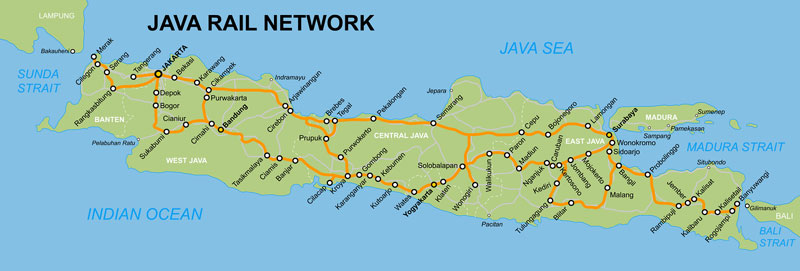
There are also many train lines in Sumatra but none of them is helpful to visit the most touristy area (like lake Toba or Bukittinggi).
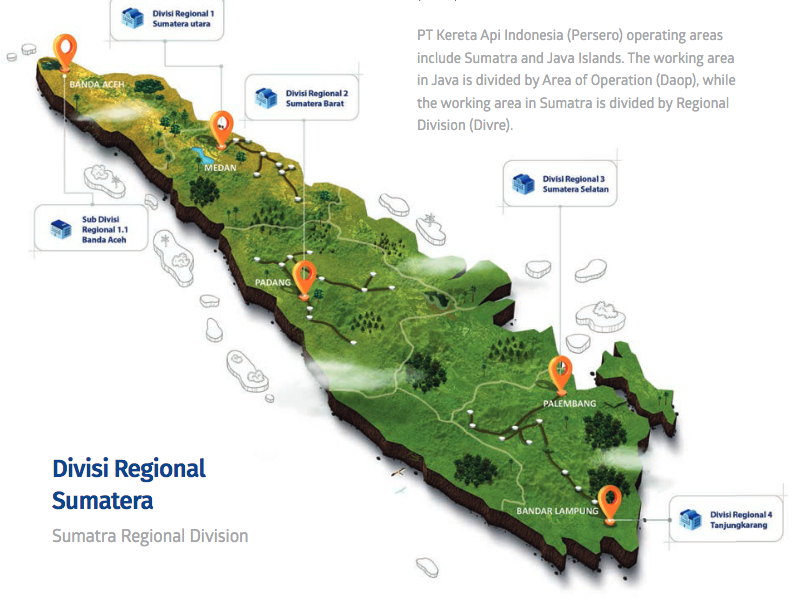
The plan of the train lines of Lampung and South Sumatra can be found here.
The plan of the train lines of North Sumatra can be found here
I haven’t found a clear plan of the train lines of West Sumatra but there is no station in Bukkittinggi.
The government has ambitious plans to further develop the train network of Sumatra (see this) as well as Sulawesi (see this)
Hi, I want to go to sumatra. is it possible to rent a car without driver?
Thank you
Hi Georges,
I guess it is even if it’s unusual for foreigners to do so. Large towns like Medan, Padang or Pekanbaru for sure have some car rental service. I have never rented a car in my life in Indonesia so I cannot really help. My advice would be to get in touch with a few car rental business in the large town that makes sense based on your itinerary.
Elliot.